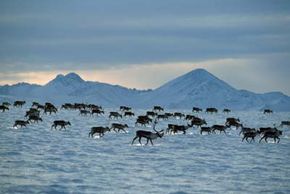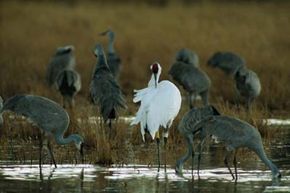Quck answer
Animal migration is the seasonal movement of animals from one place to another. It occurs for various reasons, such as to find food, mate, or better living conditions. Migration can be short or long-distance, and it can be done individually or in groups. Animals use various methods to navigate, including the position of the sun, stars, and magnetic fields. They also use landmarks, smells, and sounds to find their way. Migration can be hazardous, and animals face many challenges, such as predators, weather conditions, and human interference. Despite these challenges, migration is a crucial part of many animal species’ survival.
Animal Facts

The Porcupine caribou herd migrates in winter at the Arctic National Wildlife Refuge in Brooks Range, Alaska.
Johnny Johnson/Getty Images
Animal migrations are a sight to behold, with thousands of creatures moving in unison across the globe. These migrations are not only beautiful but also crucial for the survival of the species. In this article, we will explore some of the most incredible animal migrations in the world, why they occur, and how animals make these epic journeys.
Migration is a large-scale movement of animals from one place to another, usually triggered by changes in weather, food availability, or breeding patterns. Some migrations do not follow any pattern, while others are nomadic and move from one place to another. Partial migration occurs when some members of a species migrate while others stay in one place throughout the year.
Some animals use altitudinal migration, moving to lower altitudes when winter snow hits the upper mountains. Others use removal migration when their habitat becomes permanently inhospitable.
World Record Holders
Caribou, a species of deer-like animals, have the longest overland migration, with 3 million caribou traveling across the Arctic tundra each year. They travel to find fresh grazing grounds, covering more than 2,000 miles each year.
Although carnivorous mammals do not have regular migrations, some wolf packs may travel with a caribou herd for some distance if food becomes scarce in their home territory.
Why Do Animals Migrate?

At Bosque del Apache National Wildlife Refuge in New Mexico, a whooping crane preens among foraging sandhill cranes.
Joel Sartore/National Geographic/Getty Images
The primary reason for migration is survival. Most migrations allow a species to prosper by leaving an area when there isn’t enough food to support the population. They also prevent the depletion of food sources in one area, ensuring that each individual has a better chance of finding enough to eat.
The availability of food can be affected by various factors, such as weather and the population of other species sharing the same habitat, which can cause irregular migration patterns for certain species. Wildebeests travel throughout the African plains in search of water and grass, and their migration can change in response to the sound of thunder and sight of rainclouds. Migrations are also useful for mating and breeding, allowing young to be born in regions with richer food sources or far away from dangerous predators. The Chinook salmon and other related species swim back upriver to mate and lay eggs in the same place where they were born, ensuring that the eggs are laid in a successful spawning point. Baleen whales migrate for both food and reproduction, returning to tropical waters each winter to give birth. The whooping crane was almost wiped out due to habitat destruction, but scientists developed a method of teaching captive crane chicks how to migrate by leading them on a 1,200-mile journey from Wisconsin to Florida with the help of an ultralight aircraft.
Read More
How Do Animals Know When to Migrate?

Arctic terns fly over icebergs
Frans Lemmens/Getty Images
Animals rely on various cues to determine when to migrate. Some species use photoperiod, which is the amount of daylight in a day. As the days get shorter, animals instinctively know that winter is approaching and start moving south. Other animals react to temperature changes or internal cues, such as the amount of fat reserves in their bodies. Circadian and circannual rhythms built into an animal’s nervous system also play a role in migration patterns. These rhythms are linked to the patterns of brain activity that shift with time of day, photoperiod, and seasons.
Migration instincts developed in different species for different reasons, but for the most part, they are responses to population pressure. As the population grows and resources become scarce, some members of a species expand their range and begin living in new areas. When winter comes, and food becomes scarce, they temporarily relocate to warmer latitudes.
The migratory patterns of some animals are remarkable. For instance, the sooty shearwater bird has the longest migratory route ever confirmed by an electronic tag, traveling from New Zealand to the coasts of California, Japan, and Alaska. The Arctic tern bird may have an even longer migration route, moving from the Arctic to the Antarctic and back, racking up about 500,000 frequent flier miles in a lifetime.
One theory suggests that population pressure is the main reason for migration, while another theory claims that climate change is responsible for species moving south. In the case of monarch butterflies, they migrate over 1,000 miles to Mexico for the winter, slowing down their metabolism to survive the journey. The migration lasts longer than a typical monarch butterfly’s lifespan, and the offspring of each migrating monarch follows the same flight path as their ancestors. Animal navigation during migration is fascinating, with some species using the sun or landmarks to guide them on their journey. Whales, for example, use the continent of North America as a landmark while traveling in the Pacific Ocean.
Planetarium experiments have shown that birds use stellar cues to navigate during migration. Scent can also help animals pinpoint specific locations, while wind conditions can serve as supplementary navigation aids. Some animal species, such as bats and sea turtles, can detect the earth’s magnetic field and use it to navigate during migration. While it is unclear how these animals detect the magnetic field, some species have small particles of a magnetic mineral called magnetite in their brains, which may be reacting to the magnetic field and sending orientation information to the animal’s brain. Baby loggerhead sea turtles are able to navigate an 8,000-mile migration route using the earth’s magnetic field. Exposure to a magnet that mimicked the earth’s field set them right when they went off course.
migration, study finds
FAQ about Animal Migration
Animal migration is the movement of a particular animal species from one place to another, which is often due to seasonal changes in weather and feeding patterns or breeding and mating patterns. There are four types of migration, including complete migration, partial migration, altitudinal migration, and removal migration. There are several triggers that cause animals to migrate, such as photoperiod, temperature, internal cues, and circadian and circannual rhythms. During migration, animals navigate using different methods such as the sun, landmarks, moon and stars, scent, weather, and the earth’s magnetic field.
For more information, refer to the related HowStuffWorks articles, including How Evolution Works, How Animal Camouflage Works, How Bioluminescence Works, How Dinosaurs Work, and How Bats Work. You can also check out the great links provided such as the New York Times slideshow on Animal Migration in Southern Sudan, USGS’s Migration of Birds, and New York Times’ article on In Sudan, an Animal Migration to Rival Serengeti.
Sources of information about animal migration include Arctic National Wildlife Refuge, British Trust for Ornithology, Cornell Lab of Ornithology, National Park Service, Seaworld, University of North Carolina at Chapel Hill, University of Washington NatureMapper Program, U.S. Fish and Wildlife Service, and more. One recent study even found that bats may use magnetic polarity for migration.
The source text is a citation for an article titled “Navigation” from Physorg Biology News, dated September 20, 2007. The citation includes a link to the article on the Physorg website. The citation is presented using HTML tags for an unordered list (





Leave a Reply